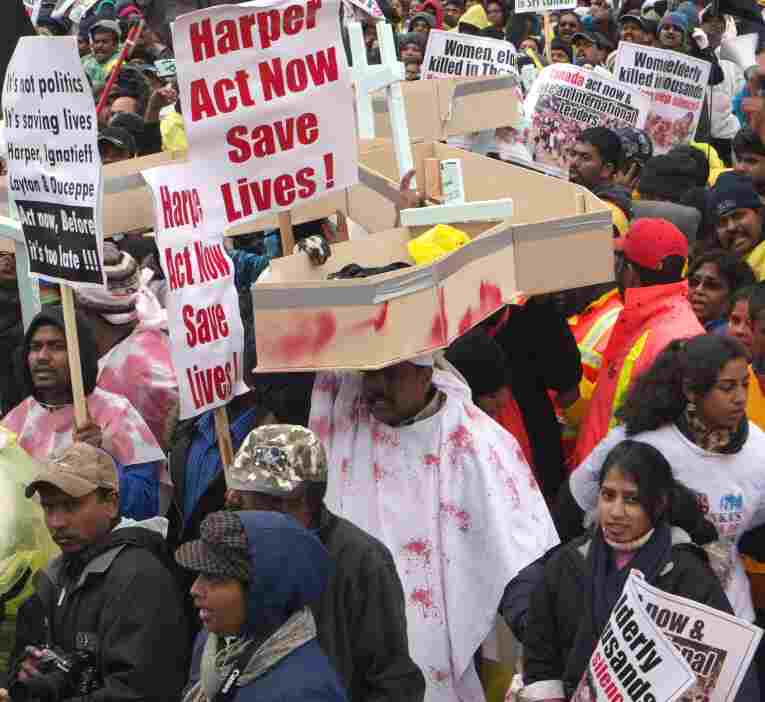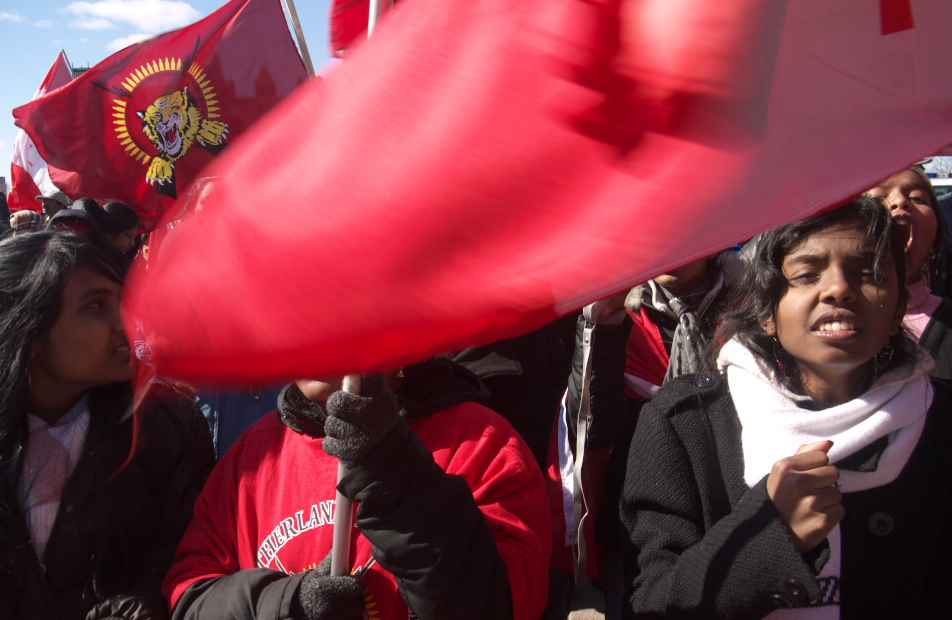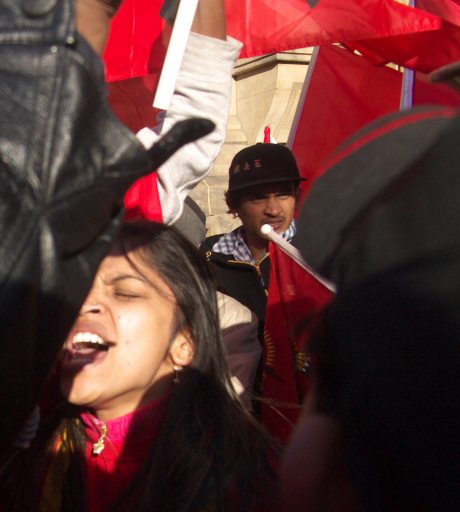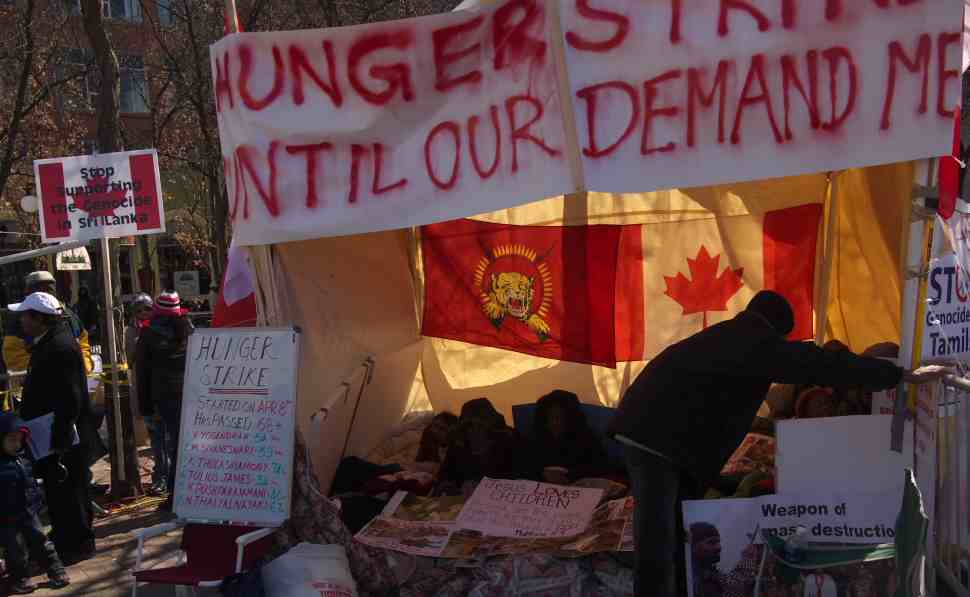There
are good reasons why Tamil-Canadians are demonstrating so fervently
in Canada. Tamil culture stretches far back in time and the
Tamils have always been a vigorous and thriving people. Evidence
of Tamil history dates as far back as 1500 B.C. from which era
there survives a Neolithic polished stone bearing Indus Valley
script. The Tamils were a seafaring people who traded with the
Romans and whose cultural influence reached China. The earliest
record of their arrival in what is now Sri Lanka is 500B.C.
It should be no surprise that a people with such a long history
have a strong identity and are proud of who they are.
It
requires serious and protracted injustice against a people to
drive them to armed struggle. Modern Tamil history
includes a long list of accusations of atrocities and genocide
at the hands of the Sri Lankan government, some documented by
Amnesty International. Complicating the issue is the fact that
the majority of Sri Lankans are Buddhists and the Tamils are
predominantly Hindu. They are two distinctly different cultures.
 Today
the Tamil rebels are trapped in a desperate last stand along
a thin strip of land on the Sri Lankan coastline. The Sri Lankan
military has the rebels surrounded and is relentlessly pounding
them despite calls for a cease-fire from Canada and the international
community. To make matters worse, there are an estimated 100,000
civilians caught in the line of fire between Tamil rebels and
Sri Lankan military forces. It is this reality which brought
Tamil-Canadians to demonstrate on Parliament Hill in Ottawa
and demand that Canada intervene on their behalf, and force
Sri Lanka to declare a cease- fire.
Today
the Tamil rebels are trapped in a desperate last stand along
a thin strip of land on the Sri Lankan coastline. The Sri Lankan
military has the rebels surrounded and is relentlessly pounding
them despite calls for a cease-fire from Canada and the international
community. To make matters worse, there are an estimated 100,000
civilians caught in the line of fire between Tamil rebels and
Sri Lankan military forces. It is this reality which brought
Tamil-Canadians to demonstrate on Parliament Hill in Ottawa
and demand that Canada intervene on their behalf, and force
Sri Lanka to declare a cease- fire.
I
was not prepared for what I found the first day I went to Parliament
Hill. There were perhaps a thousand people lined up along the
sidewalks on both sides of the street shouting, vigorously waving
the brilliant red flags of Canada and the unofficial Tamil nation
flag, and wielding placards with large blue and red slogans
written on them.  There
was a tent housing several people who had launched a hunger
strike.
There
was a tent housing several people who had launched a hunger
strike.
Maybe
50 to 100 demonstrators were sitting directly on the street.
The sitters, supported by a relentless tide of chanting, were
protected by barricades and watched by a large contingent of
patient, yellow-vested police. The police were there mostly
to ensure that commuters driving to their homes and families,
tired and impatient after a day's work, didn’t fall into
conflict with the demonstrators. Along the whole length of the
opposing sidewalks, barricades held the fervent crowd from drifting,
despite themselves, into the way of traffic.
*
* * * * * * * * *
 It
is April 21st, the last day of demonstrations. The demonstrators
have been coming to the Hill every day now for the past 14 days,
peacefully occupying the sidewalks, gesturing with their bright
placards and chanting loudly. They no longer sit on the street
for fear of alienating public opinion. Every day the demonstrators
have been taking up their place behind the sidewalk barricades,
and from the moment they arrive to the end of the day, these
men, women and children almost never cease chanting, halting
only occasionally to hear a speaker deliver some short speech
or a series of instructions through a bullhorn, after which
the tide of shouting rises again, joined by other bullhorns
and a mantra of voices, many of which are hoarse.
It
is April 21st, the last day of demonstrations. The demonstrators
have been coming to the Hill every day now for the past 14 days,
peacefully occupying the sidewalks, gesturing with their bright
placards and chanting loudly. They no longer sit on the street
for fear of alienating public opinion. Every day the demonstrators
have been taking up their place behind the sidewalk barricades,
and from the moment they arrive to the end of the day, these
men, women and children almost never cease chanting, halting
only occasionally to hear a speaker deliver some short speech
or a series of instructions through a bullhorn, after which
the tide of shouting rises again, joined by other bullhorns
and a mantra of voices, many of which are hoarse.
Street
monitors were helping the police manage the crosswalks. There
was no hostility toward photographers; indeed, they were treated
with the greatest respect and cooperation. Men walked among
the crowd distributing food from large boxes while others, holding
large garbage bags, toured the streets to pick up any litter
of which, by the way, there was very little.

I
was among the 33,000 Canadian-Tamils on Parliament Hill, but
this time they crowded onto the lawn in front of the Peace Tower.
Despite the coolness and the rain, they had come by car, bus,
train, and airline from as far away as Montreal and Toronto
and perhaps from locations more distant. The demonstrators gathered
in front of the Peace Tower left an unrestricted path down their
centre. It was a simple matter to walk down its length to take
close-up photographs of the speakers.
Red
placards swayed back-and-forth above the thick, sprawling crowd
like the necks of nervous flamingos. Large banners with their
letter-large slogans were held high, distended against the wind.
The air throbbed with the frenetic beating of drums and surges
and swells of loud chanting.
 But
there were no Tamil flags because the Canadian government has
classified the Tamil rebels as terrorists. No politician could
be seen addressing a crowd flying a flag that so closely resembles
the rebel flag. The thousands of demonstrators who had arrived
on the Hill, instead, brought black flags to protest the killing
that was still on-going in Sri Lanka -- even as they stood there
before the Peace Tower shouting for the government of Canada
to insist on a cease-fire.
But
there were no Tamil flags because the Canadian government has
classified the Tamil rebels as terrorists. No politician could
be seen addressing a crowd flying a flag that so closely resembles
the rebel flag. The thousands of demonstrators who had arrived
on the Hill, instead, brought black flags to protest the killing
that was still on-going in Sri Lanka -- even as they stood there
before the Peace Tower shouting for the government of Canada
to insist on a cease-fire.
These
demonstrations are the war in Sri Lanka brought to the streets
of Ottawa. Walking among these people was like walking among
troops on a battlefield. Their intensity and ferocity was the
intensity and ferocity of a desperate last stand at the front
lines. The horror of Sri Lankan slaughter is being played out
on our streets by these demonstrators for whom every report
of death in Sri Lanka is like a wound torn open on their own
bodies.
Yet,
here in Ottawa, the demonstrators have responded with remarkable
restraint and civility. The self-discipline they exhibited,
despite overwhelming personal anguish, was a compelling expression
of their passion in unity and deep respect for Canadian law.
The
discipline and civility displayed by the Tamil demonstrators
on Parliament Hill was consistent with Canadian values. Indeed,
Canada is the type of civil society that people in conflict
around the world wish for themselves. But what happened on the
Gardiner Expressway mirrors the kind of anarchy we see in Sri
Lanka today. If the Tamil demonstrators desire a civil society
in Sri Lanka, they must show respect for it here or lose trust
and support among their fellow citizens.
It
remains for the Tamil organizers to offer an explanation, and
beyond that, a sincere, deeply felt apology to the city of Toronto,
with the promise not to repeat such an act again. They might
consider issuing a declaration to the effect that they regard
Canada as an example of the sort of civil society they would
like to see in their homeland.
Canadians
are appalled at the violence and loss of life taking place in
Sri Lanka today, and are sympathetic to Tamil demands for a
cease-fire. But Canadians also know that when civil society
and the rule of law break down, tragedy ensues.
The
discipline the Tamil-Canadians displayed on Parliament Hill
won many supporters. It was a profound expression of sincere
emotion and earned them deserved respect. May it become their
common practice. It will show the sort of society they want
to help grow in their homeland. Unlawful protest will only demonstrate
that the demonstrators want to bring the sort of disorder reigning
in their homeland to this country and it will lose them all
respect in the eyes of their fellow citizens.
Photos © Bernard Dubé
Also
by Bernard Dubé:
Interview
of Arlo Guthrie
Critique
of John S. Gordon